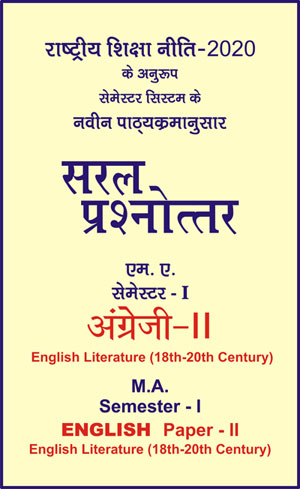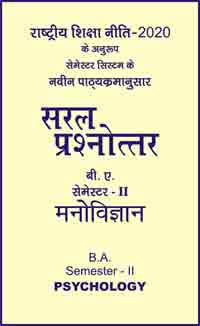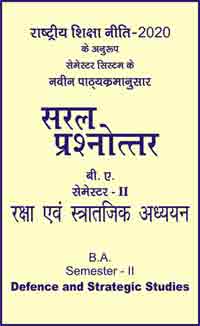|
बी ए - एम ए >> एम ए सेमेस्टर-1 - अंग्रेजी - द्वितीय प्रश्नपत्र - अंग्रेजी साहित्य 18वीं-20वीं शताब्दी एम ए सेमेस्टर-1 - अंग्रेजी - द्वितीय प्रश्नपत्र - अंग्रेजी साहित्य 18वीं-20वीं शताब्दीसरल प्रश्नोत्तर समूह
|
5 पाठक हैं |
|||||||
एम ए सेमेस्टर-1 - अंग्रेजी - द्वितीय प्रश्नपत्र - अंग्रेजी साहित्य 18वीं-20वीं शताब्दी
Question- What are the various themes in the novel?
Answer -
The various themes in the novel are -
(i) The Nature of Virtue - Richardson's novel has often given the impresion of defining 'virtue' too narrowly and negatively, as the physical condition of virginity before marriage. To begin with, Pamela makes a sensible distinction between losing her virginity involuntarily and acquiescing in a seduction. Only the latter would be a transgression against sexual virtue. Moreover, almost the entire second half of the novel is taken up with the explication and praise of Pamela's positive qualities of generosity and benevolence. Mr.B values these qualities and they have brought him to propose marriage reading her journal, he has discovered her genuine goodwill toward him, particularly in her rejoicing over his escape from death by drowning. As a result, Pamela's active goodness merits the 'reward' of a happy marriage as much as her defense of her virginity.
(ii) The Integrity of the Individual - Richardson's fiction commonly portrays individuals struggling balance incompatible demands on their integrity. Pamela, for instance, must either compromise her own sense of right or offend her. Master, who deserves her obedience except in so far as he makes illicit demands on her. This highly conscientious servant and Christian must work scruplously to defy her. Master's will only to the degree that is necessary to preserve her virtue, to do any less would be irreligious, while to do anymore would be contumacious and the successfull balance of these conflicting claims represents the greatest expression of Pamela's personal integrity.
(iii) Class Politics - One of the greatest-social facts of Richardson's day was the intermingling of the aspirant middle class with the gentry and aristocracy. The eighteenth century was a golden age of social climbing and thereby of satire (primarity in poetry), but Richardson was the first novelist to turn his serious regard on class different and class tension. Pamela's class status is ambiguous at the start of the novel. She is on good terms with the other Bedfordshire servants, and the pleasure she takes in their respect for her shows that she does not consider herself above them; her position as a lady's maid, however, has led to her acquiring refinements of education and manner that unfit her for the work of common servants; when she attempts to scour a plate her soft hand develops a blister. Moreover, Richardson does some fudging with respect to her orginis when he specifies that her father is an educated man who was not always a peasant but once ran a school.
If this hedging suggest latent class snobbery on Richardson's part, however, the novelist does not fail to insist that those who receive privileges under the system bear responsibilities also, and correspondingly those on the lower rungs of the ladder are entitled to claim rights of their superiors. Thus, in the early part of the novel, Pamela emphasizes that Mr.B, in harassing her, violates his duty to protect the social inferiors under his care, after his reformation in the middle of the novel, she repeatedly lauds the "Godlike Power" of doing good that is the special pleasure and burden of the wealthy.
(iv) Sexual Politics - Sexual inequality was a common theme of 18th century social commentators and political philosophers. Though Richardson's decision to have Pamela fall in love with her would-be rapist has rankled many advocates of women's rights in recent years, he remains in some sense a feminist writer due to his sympathetic interest in the hopes and concerns of women. He allows Pamela to comment acerbically on the hoary theme of the sexual double standard.
Richardson's sympathy for the feminine view of things emerges in his presentation of certain contracts between the feminine and masculine psyches. Pamela's psychological subtlety counters Mr.B; simplicity, her emotional refinement counters his crudity, and her perceptiveness defeats his callousness, with the result that Mr.B must give up his masculine aggressive persona and embrace instead the civilizing feminine values of his new wife.
(v) Psychology and the Self - In composing Pamela Richardson wanted to explore human psychology in ways that no other writer had. His innovative narrative method, in which Pamela records her thoughts as they occur to her and soon after the events that have inspired them, he called 'writing to the moment'.
Although the overt plot of the novel addresses Mr. B's efforts to invade the recesses of Pamela's physical person, the secondary plot in which she must defend the secrecy of her writings shows the Squire equally keen to intrude upon her in most Psyche. Beginning with the incident in Letter I when she reacts to Mr. B's sudden appearance by concealing her letter in her bosom, Pamela instinctively resists her Master's attempts to expose her private thoughts as she says, what-one writes to one's Father and Mother is not for everybody. It is not until Mr. B learns to respect both Pamela's body and writings, relinluishing access to them except when she voluntarily offers it, that he becomes worthy of either physical or psychological intimacy with her.
(vi) Hypocrisy and Self-knowledge - Since the initial publication of Pamela in 1740, critics of Richardson's moralistic novel have accused its heroine of hypocrisy, charging that her outentible virtue is simply a reverse psychological play for attracting Mr. B. This criticism has a certain merit, in that Pamela does indeed turn out to be more positively disposed towards her master than she has let on; in her defense, however, her misrepresentation of her feelings has not been deliberate, as she is quite the last person to figure out what her 'treacherous, treacherous Heart' has felt.
The lovers in the novel remain at cross-purposes when they should be coming together, and only Mr. B's persistence secures the union that Pamela's suspicions have jeopardized.
(vii) Realism and Country Life - 18th century literature tended to idealize the life of rustic simplicity that Pamela typifies. Dramatists were found of rendering the tale of the liantious squire and the chaste maiden in a high romantic strain. Richardson, however, disappoints the idyllic expectations by having Pamela tell her story in the 'low' style that is realistically appropriate to her class, as well as through his generous incorporation of naturalistic details. Far from Idealizing the countryside, Richardson recurs to the dirt in which Pamela conceals her writings and plants her horse beans.
In selecting his imagery, Richardson favours not the wood nymphs and sentimental will ows of pastoral romance but such homely items as Pamela's flannel, Mr. B's boiled chicken, the Carp in the pond, the grass in the garden, the mould, a cake, and the shoes that Mrs. Jewkes periodically confiscates from Pamela. To discover dramatic significance, Richardson does not look to the great cities and the exemplars of public greatness who reside there; he maintains, rather, that much of equal or greater significance inherent in the private actions and passions of common people.
|
|||||
- Question- Describe Social and Historicals movements of post modern world wars (I & II).
- Question- Explain the meaning of Romanticism and the Romantic period.
- Question- What is Industrial revolution? Give its main characteristics.
- Question- Write a short biography of John Stuart Mill.
- Question- Write a detail note about Darwinism.
- Question- What do you know about modernism in English Literature?
- Question- What are some main characteristic features of modernism or in modernist literature?
- Question- What do you know about Modernism in Literature? Study it under the following heads- 1. Modern Fiction 2. Modem Poetry 3. Modern Drama.
- Question- What was the 20th century known for?
- Question- What is the theme of 20th century literature?
- Question- Write a note on 'Subjection of women'
- Question- Provide a summary on The Subjection of women chapter I'.
- Question- What is the structure of the Subjection of women?
- Question- What is social and legal status of women?
- Question- Describe Arnold as a prose writer.
- Question- "The pursuit of perfection is the pursuit of sweetness and light". Elucidate.
- Question- How does Arnold say that culture and religion are not in conflict with each other?
- Question- What is according to Arnold the ultimate goal of culture?ply
- Question- How does Arnold criticise the Puritans?
- Question- Write a note on the contribution made to English thought by Ruskin.
- Question- Describe characteristics of Ruskin's socialism.
- Question- Write the summary of the essay The Roots of Truth from "Unto The Last" by John Ruskin.
- Question- Write a note on Ruskin as an art critic.
- Question- Summarise Ruskin's views in Lecture on Work.
- Question- Attempt a critical Analysis of "The Queen's Looking Glass" Written by Gilbert and Gubar.
- Question- Describe the looking glass reveals the existence of patriarchy throughout various fairytales.
- Question- What are the different ways in which women tend to immerse themselves in unhealthy obsessions, and why do they do this?
- Question- What are some of the central dilemmas facing the "independent woman" in de Beauvoir's time?
- Question- How does de Beauvoir respond to those who believe that granting women greater equality means losing the "spice" of life?
- Question- Write a detailed note on Jean-Paul Sartre.
- Question- Write an essay on Existentialism and The Human Emotions.
- Question- Provide a background to Albert Camus's Myth of Sisyphus.
- Question- Provide a summary of the myth of Sisyphus.
- Question- What do you know about Myth of Sisyphus Chapter 1?
- Question- Write a short note on the life-sketch of Albert Camus.
- Question- Evaluate 'Rape of the Lock' as a mock heroic epicpoem.
- Question- What picture of the eighteenth century social life do we find in 'the Rape of the Lock'.
- Question- What did Belinda see in her sleep?
- Question- Discuss Clarrisa's speech in "The Rape of the Lock".
- Question- What items of toiletry stood displayed on Belinda's table in Canto I of "The Rape of the Lock'?
- Question- Discuss Wordsworth's contribution to English criticism.
- Question- Give a critical estimate of Wordsworth's 'Preface to Lyrical Ballads'.
- Question- Summarise William Wordsworth's views on Appendix on poetic diction.
- Question- Write a critical Appreciation of the poem "Tintern Abbey".
- Question- How is "The Rime of the Ancient Mariner' a romantic poem?
- Question- What are some important themes in The Rime of Ancient Mariner'?
- Question- Comment on the use of some important symbols in the poem.
- Question- What do you know about the poem The Rime of the Ancient Mariner'? What is it all about?
- Question- Provide the summary of Part-I of the poem.
- Question- Provide a detailed summary of Part-II of The 'Rime of Ancient Mariner'.
- Question- Provide a summary of Part-III of The Rime of Ancient Mariner'.
- Question- Prodived summary of part-IV of "The Rime of Ancient Mariner'.
- Question- Provide a summary of Part-V of the poem.
- Question- Provide a summary of Part-VI of the Poem.
- Question- Provided a summary of Part-VII of the poem.
- Question- Comment upon limitations of Shelley as a poet.
- Question- Analyse Shelley's treatment of nature.
- Question- Critically examine Shelley's "To a Skylark”.
- Question- Write a note on the use of poetic devices and figures of speech as used in the poem.
- Question- Critically appreciate the poem 'Uphill' in your own words.
- Question- Understand the poem under the following heads.
- Question- What do you know about the poem 'Uphill' ?
- Question- Provide the summary of the poem in your own words.
- Question- How is the poem 'Uphill' a poem of faith, doubt and religious vision?
- Question- Write a note on Eliot's life and works.
- Question- Write a note on the structure of Eliot's 'The Waste Land'.
- Question- Eliot's "The Waste Land' is an expression of the disillusionment of a Generation.'
- Question- How does Eliot explore suffering and hope in The Waste Land' and other poems ?
- Question- Analyse "A Game of Chess".
- Question- What is the significance of Da', 'Da, Da' in the last section of "The Waste Land' entitled 'What The Thunder Said'.
- Question- What are some important themes dealt with in The Second Coming'?
- Question- How is W.B. Yeats' poem The Second Coming' an apocalyptic poem ?
- Question- What is your view is Yeats contribution to modern poetry?
- Question- Write a note on the life of W.B. Yeats and his quest for Irishness.
- Question- How does The Second Coming' reflect the historical context of the time in which it was written?
- Question- How (and why) does The Second Coming' use mythology and ancient themes to express the onset of modernity?
- Question- Describe Yeats The Second Coming' in relationship to several works it has inspired. Why has 'The Second Coming' persisted in the popular imagination.
- Question- Is the 'rough beast' necessarily an evil thing?
- Question- Comment on the use of symbols in the poem.
- Question- What are the various literary devices used in the poem?
- Question- Provide a summary of the poem in your own words.
- Question- "Wilfred Owen as a War Poet". Explain it.
- Question- Give the brief summary of the poem 'Futility' by Wilfred owen.
- Question- Write a critical appreciation of the poem 'Futility'.
- Question- What kind of poem is 'Futility' by wilfred Owen ?
- Question- How does the poet express the pity of war in 'Futility"?
- Question- What is the meaning of the poem 'Futility' by William Blabe?
- Question- What is the main theme of the poem 'Futility"?
- Question- What influenced Wilfred Owen to write war poetry?
- Question- What is the poet's attitude towards war in the poem. 'Futility"?
- Question- 'Was it for this the clay grew tall?' Bring out the Significance of this line?
- Question- 'Move him into the Sun'.............Who is the speaker? Who is to be moved and why?
- Question- 'O What made fatuous Sunbeams toil'....... Why did sunbeams toil? Why are they called fatuous?
- Question- To break earth's sleep at all ?...... What does the poet mean by 'to break earth's sleep?
- Question- Bring out the important themes of the poem, 'Hawk Roosting.'
- Question- How is the poem a dramatic monologue ?
- Question- Provide stanza-wise explanation of the poem.
- Question- Discuss the poem 'Hawk Roosting' as a comment on human society.
- Question- Write a short biography of Ted Hughes.
- Question- Comment on the physical features of the hawk highlighted in the poem and their significance.
- Question- How does the poem emphasize the physical prowess of the hawk ?
- Question- "There is no sophistry in my body' - this statement expresses the brutal frankness of the hawk. Does the poet suggest something through this statement ?
- Question- 'Now I hold Creation in my foot' explain the centrality of this assertion in the poem. What makes the hawk's assertion of its invincibility so categorical?
- Question- Why is the poem titled, 'Hawk Roosting'?
- Question- Bring out the parallel suggested between the predatory instincts of the bird and human behaviour.
- Question- Give a detailed account of life and career' works, influences and achievements of Seamus Heaney.
- Question- How would you visualize Seamus Heaney as a poet?
- Question- Give critical analysis of the poem 'Digging' by Seamus Heaney.
- Question- Discuss the themes used in the poem - 'Digging'.
- Question- Write a biographical note on Synge.
- Question- Provide a summary of the Riders to The Sea.
- Question- What are some important themes of the play?
- Question- Provide a detailed character sketch of Maurya.
- Question- How is 'Riders to the Sea' a classical tragedy?
- Question- What is the role of the sea in 'Riders To The Sea' by J.M. Synge?
- Question- Write a note on the use of symbols in Riders to the Sea.
- Question- Write a note on the popularity of the play.
- Question- Write a note on the human relationship in the play 'Look Back in Anger'.
- Question- Describe Alison's account of her marriage given to Helena.
- Question- Write a note on the title of the play 'Look Back in Anger'.
- Question- Give a brief analysis of the opening scene of 'Look Back in Anger.'
- Question- Give a brief summary of Samuel Beckett's life?
- Question- What is the message given through this play 'Waiting for Godot'?
- Question- Waiting for Godot is a metaphor of human life. Comment.
- Question- Vladimir and Estragon are the main characters of the play 'Waiting for Godot'. Give a brief idea about their characters ?
- Question- Pozzo and Lucky are a pair of master and slave. How was their relationship with each other.
- Question- Harold Pinter as the Absurdist-Existentialist playwright. Explain it.
- Question- What is the theme of the play. "The Home coming" writer by Harold Pinter.
- Question- Writer a brief summary the play, "The Homecoming" written by Harold Pinter.
- Question- What is Harold Pinter's style to writing?
- Question- What is the primary focus of Pinter's Writing in the Homecoming?
- Question- Whose Homecoming it?
- Question- What role of morality in the play "The Homecoming"?
- Question- How does Pinter Portray women and family in The Homecoming?
- Question- What are the issue of misogyny and gender in Harold Pinter's Homecoming?
- Question- What is the general theme of Gulliver's Travels.
- Question- Describe the character of Gulliver in detail.
- Question- Write a note on the realistic effect in Gulliver's Travel.
- Question- Comment upon womenhood and its implications in Richardson's Pamela.
- Question- What are the various themes in the novel?
- Question- Critically appreciate the novel.
- Question- Write a short note on Samuel Richardson.
- Question- Provide a detailed Summary of Pamela; or Virtue Rewarded.
- Question- What is the main theme of the novel?
- Question- Comment on the class differences which is quite a striking feature in Richardson's Pamela.
- Question- Give the character sketch of Pamela.
- Question- What is an Epistolary Novel? What are the advantages and disadvantages of epistolary writing? Explain with reference to the novel 'Pamela'.
- Question- Comment on the society in 18th and 19th Century England.
- Question- What do you know about the earlier affairs in the novel?
- Question- Attempt the character sketch of Mr. B.
- Question- What do you understand by the Industrial Revolution? In what way do you think it changed the relationship between various social groups. Do you think such changes are inevitable?
- Question- Comment on the narrative technique in the novel; 'Wuthering Heights'.
- Question- Provide a summary the novel.
- Question- What do you regard Heathcliff as a Byronic or a Romantic Hero or both? Reason your answer.
- Question- What is the significance of Hindley's remark that his sister looks like a 'lady'? Is lady' the same as 'memsahab?
- Question- How is the institution of marriage discussed in the novel? Elaborate with reference to the Victorian age.
- Question- How does the novel give enough proof of the patriarchal society and how Catherine tries to oppose the malecentric norms set in ?
- Question- What are some important themes of 'Wuthering Heights"?
- Question- How is prison used as a motif in 'Wuthering Heights'.
- Question- Write a short note on the life and works of Emily Bronte.
- Question- Write a short note on Charlotte Bronte.
- Question- Attempt a character Sketch of Jane Eyre.
- Question- How does Charlotte Bronte incorporate elements of the Gothic tradition into the novel?
- Question- Is Jane Eyre a likable protagonist? Why or why not?
- Question- How does Jane Eyre compare to Bertha Marton?
- Question- How does the novel comment on the position of women in Victorian society?
- Question- Considering his treatment of Bertha Mason, is Mr. Rochester a sympathetic or unsympathetic character?
- Question- How does Mr. Rochester compare to St. John Rivers ?
- Question- What is the role of family in the novel?
- Question- Why is Jane unable to stay with Mr. Rochester after his marriage to Bertha Mason is revealed?
- Question- What is the significance of Charlotte Bronte ending the novel with a statement from St. John Rivers?
- Question- Considering the various times the moon appears, what is the significance of the moon motif in Jane Eyre?
- Question- How does Bronte use descriptions of nature in Jane Eyre to set mood?
- Question- Provide a summary of the novel.
- Question- What are the major themes of the novel?
- Question- Give a detailed character sketch of Marlow.
- Question- Provide a detailed character sketch of Mr. Kurtz.
- Question- Critically analyse the various aspects of 'Heart of Darkness'.
- Question- What are the effects of the narrative frame as it is introduced in part of Heart of Darkness?
- Question- In part 1 of Heart of Darkness, what mood is created through the narrator's description of the tide, river and ships?
- Question- What effect does Conrad achieve in Heart of Darkness by layering the narrator's Marlow's and Kurtz's voices in the story?
- Question- In what ways does Kurtz's African mistress in Heart of Darkness contrast with Marlow's aunt and Krutz's Intended?
- Question- In Part 1 of Heart of Darkness, how does the African slave wearing 'white worsted' around his neck in the thicket of death develop the theme of imperialism?
- Question- In heart of Darkness, what are two ways in which Marlow penetrates 'deeper and deeper into the heart of darkness'?
- Question- In the novel, what does Marlow mean when he says that human beings need a 'deliberate belief" in their research for meaning of truth?
- Question- How does the setting of Heart of Darkness support the truth of Marlow's assessment regarding Kurtz that 'the essentials of this affair lay deep under the surface'?
- Question- In the novel, how does the the content of Kurtz's report for the International Society for the Suppression of savage custom contract with the poetscript?
- Question- In what ways are Marlow and Kurtz similar in 'Heart of Darkness'?
- Question- In Heart of Darkness, how does the Russians' clothing resemble the map of Africa in the company office?
- Question- How does the three part division of the Heart of Darkness function?
- Question- During the journey down the river in Heart of Darkness, What is Marlow's relationship with the manager and with Kurtz ?
- Question- In the novel, how do both Kurtz and his Intended suffer from self-delusion?
- Question- How are the beginning and the end of Heart of Darkness similar?
- Question- In what ways is Heart of Darkness a modernist novella?
- Question- D.H. Lowerence novel, 'Women in Love' is called modern man's divided nature. Explain it.
- Question- What are relationship between the works of Lawerence and Nietzschean philosophy 'In women in Love.' novel?
- Question- Character analysis of Gerald Crich and Ursula in novel 'Women in Love'?
- Question- Write a note on plot summary of the novel 'Women in Love.'
- Question- What is the theme of women in love by D. H. Lawerence ?
- Question- What are different themes of 'Women in Love"?
- Question- The two central female characters in 'Women in Love' are both lively and independent. What do the Brangwen sisters (female Characters) tell us about Lawerence's society?
- Question- Describe Gerald Crich and Rupert Birkin's relationship. What does their struggle represent, and why is it so central to the novel?
- Question- In novel 'Women in Love' what is the key difference between Ursula and Gudrun and why is it important for understanding the novel?
- Question- The two central male characters in 'Women in Love' are spirited individual with their social world. Compare and contrast Birkin and Gerald.
- Question- Women in love contains many thoughtful literary allusions most of which are made by Birkin. Choose some key examples and discuss the role they play during important scenes in the novel.
- Question- What are the important themes of 'A Portrait of the Artist as a Young Man' ?
- Question- Comment on the artistic alienation in James Joyce's Portrait of the Artist As a Young Man.
- Question- How is the novel an aesthetic autobiography of James Joyce?
- Question- Analyse the novel critically paying special emphasis on the character of Stephen Dedalus.
- Question- Write a short note on James Joyce.
- Question- Comment on the overall structure of the novel.
- Question- What do you know about Stephen Dedalus ?
- Question- What do you think of the various women that come in Stephen's life in the novel?
- Question- Comment on repetition and symbolism as literary devices used in the novel.
- Question- How is stream-of-consciousness technique employed in 'A Portrait.......? Give one example of epiphany from the novel.
- Question- What do you know about the aesthetic theory put forward by Stephen?
- Question- Provide a detailed summary of the novel.
- Question- Write a note on the symbolic significance of the novel 'To The Light House'.
- Question- Discuss the stream of consciousness technique as used by Virginia Woolf in To The Light House'.
- Question- Write a note on the character of Mrs. Ramsay.
- Question- 'Her novels have been greeted as original experiments in a new technique of fiction, the explorations of the consciousness replacing the exploration of event. 'Discuss with reference to Virginia Woolf's To The Light House'.
- Question- Discuss the theme of the novel To The Lighthouse'.
- Question- Sketch briefly the character of Lily Briscoe.
- Question- 'Consider the novel To The Lighthouse' as a psychological novel.
- Question- How is Mr. Ramsay opposite to Mrs. Ramsay?
- Question- Who is James Ramsay? Who role does he play in "To The Lighthouse"?














